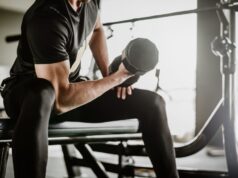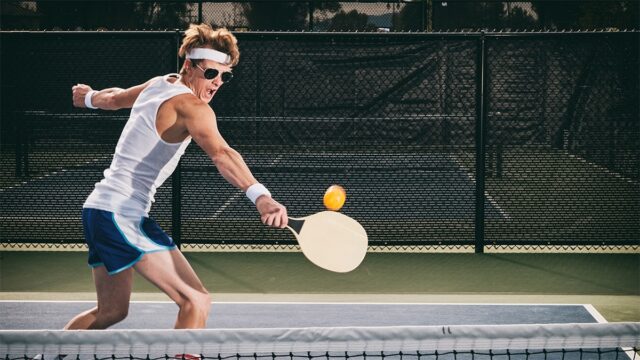
Pickleball, a paddle sport that combines elements of tennis, badminton, and ping-pong, has surged in popularity across various age groups due to its fun, social nature, and accessibility.
However, while pickleball is celebrated for its health benefits, including improved physical fitness, coordination, and mental well-being, the sport’s physical demands can also generate a range of musculoskeletal issues, particularly in the back and hips.
Common complaints amongst pickleball enthusiasts include lower back pain, sciatica (pain that radiates along the path of the sciatic nerve), hip flexor strain, and piriformis syndrome (a condition that causes buttock pain). These issues can stem from overuse of the relevant muscles, improper playing technique, inadequate warm-up and stretching, or simply the high-impact nature of the game on hard court surfaces.
Understanding the causes and symptoms of back and hip woes is the first step toward addressing and preventing them, ensuring that players can continue to enjoy pickleball without pain or injury.
Understanding the Causes of Pain
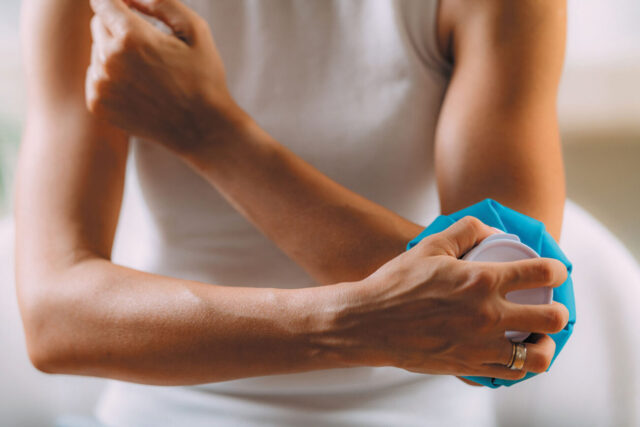
Pickleball’s rapid movements and strategic gameplay put players at risk of back and hip pain. This section explores how the sport’s mechanics contribute to creating these common issues and also the impact of repetitive motion and equipment on player well-being.
Mechanics and Pain
Pickleball demands quick lateral moves and sudden stops, which can stress the lower back and hips. Continuous play without proper breaks can lead to muscle fatigue and stiffness, directly linking the game’s dynamics to potential discomfort.
Repetitive Movements
The sport’s repetitive nature, from serving to volleying, strains the body. Improper form or uneven muscle use exacerbates this, and generates overuse injuries. The hard court surfaces further amplify stress on the body, increasing injury risk.
Technique and Equipment
Incorrect technique, such as poor posture or inadequate core engagement, contributes significantly to causing pain. Unsuitable equipment like heavy paddles or unsupportive shoes can also worsen strain, highlighting the need for proper gear and form for a safer play experience.
Common Back and Hip Injuries in Pickleball
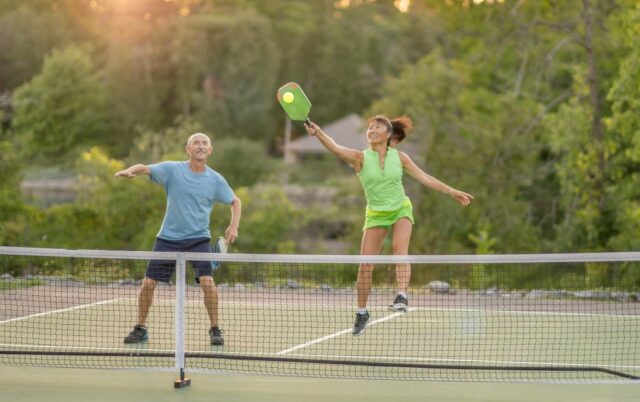
Pickleball’s physical demands can cause several common injuries that affect the back and hips. Understanding these conditions helps players seek appropriate treatment and implement preventive measures.
Lower Back Pain
This is a frequent complaint amongst pickleball players due to the sport’s demand for quick directional changes and bending motions. It often results from a muscle strain or ligament sprain caused by sudden movements, or from prolonged play without gaining adequate core strength.
Sciatica
This is characterized by pain that radiates along the path of the sciatic nerve, from the lower back down to the legs. In pickleball, sciatica can be the result of overuse, improper stretching or acute injury, and create pressure on or irritation of the nerve.
Hip Flexor Strain
This injury occurs when the muscles in the front of the hip are overstretched or torn, often as a result of explosive movement like lunging for the ball. Symptoms include pain in the hip or groin area, especially when lifting the knee towards the chest.
Piriformis Syndrome
This is a less common but painful condition in which the piriformis muscle, located in the buttock region, irritates the sciatic nerve. Its symptoms mimic sciatica, with pain and numbness in the buttocks and along the leg. It can develop from repetitive twisting movements or direct impact.
Recognizing the symptoms and causes of these injuries is crucial for timely intervention and recovery, which will enable pickleball players to continue to enjoy the game while minimizing the risk of long-term damage.
Prevention Strategies
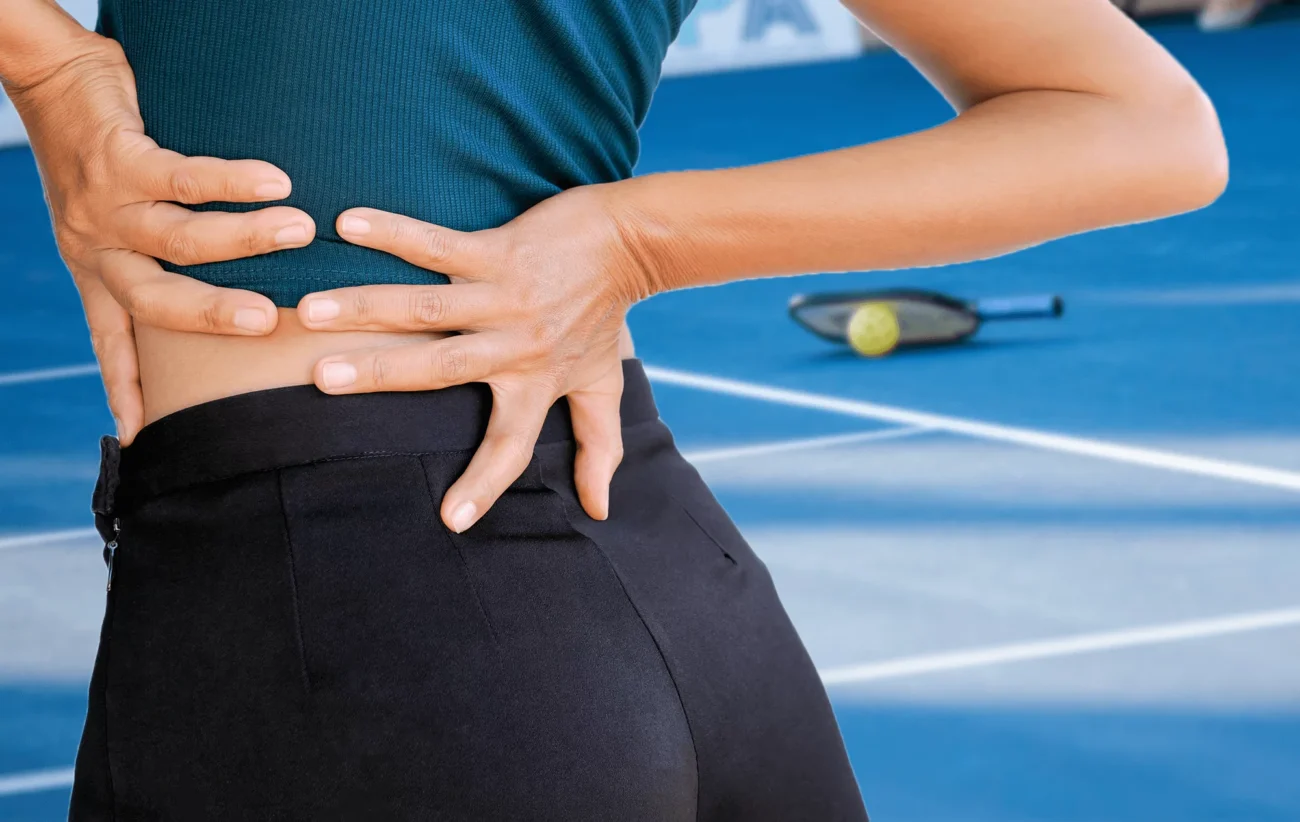
Preventing back and hip injuries in pickleball is key to enjoying the game long-term. Implementing effective prevention strategies can significantly reduce the risk of pain and injury, enhancing overall performance and enjoyment.
Warm-Up and Cool-Down Routines
- Warm-up ─ Begin with dynamic stretches to prepare the body for the range of motions required in pickleball. Include exercises like leg swings, arm circles and gentle jogging to increase heart rate and blood flow to muscles.
- Cool-down ─ After playing, conduct static stretching focusing on the back, hips, and legs to reduce muscle tightness and promote flexibility. This aids muscle recovery and prevents stiffness.
Flexibility and Strength Training
- Flexibility ─ Incorporate yoga or Pilates into your routine to improve flexibility, especially in the back and hips. Stretch regularly to maintain muscle elasticity, which is crucial for preventing strains.
- Strength ─ Strengthening the core, glutes, and leg muscles supports the lower back and hips, reducing the burden on these areas during play. Exercises like planks, squats and lunges are beneficial.
Proper Form and Technique
Maintain a neutral spine and engage your core during play to protect your back. Learn the correct techniques for serving and returning shots to minimize awkward movements that can lead to injury.
Work with a coach or experienced player to ensure your playing style doesn’t put unnecessary strain on your body.
Equipment Recommendations
- Paddles ─ Choose a paddle that feels comfortable in weight and grip size to avoid overexertion of the arm and shoulder muscles, which can indirectly affect the back and hips.
- Footwear ─ Wear shoes designed for court sports, which offer good support and cushioning which will absorb impacts and reduce stress on the lower back and hips.
- Supportive gear ─ Consider using compression garments or braces if you have a history of back or hip issues, as these can provide additional support and stability during play.
Treatment Options for Back and Hip Pain
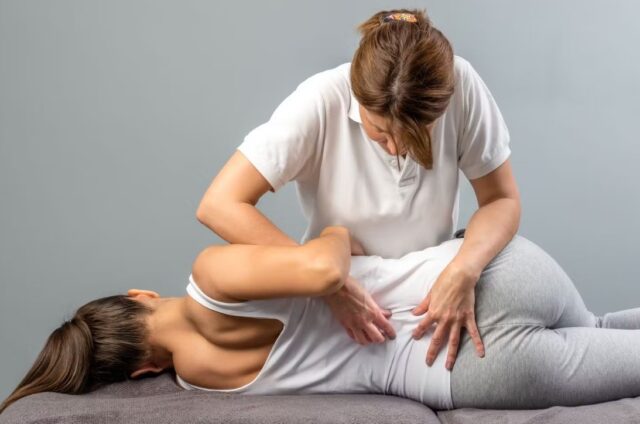
Effective management and treatment of back and hip pain are crucial for pickleball players to maintain their performance and enjoyment of the game. Here’s how to address these common ailments, ranging from home remedies to professional interventions.
Home Remedies and Self-Care Measures
- Ice and heat therapy ─ Apply ice packs to reduce inflammation during the first 48 hours after injury, followed by heat therapy to relax muscles and improve blood circulation.
- Over-the-counter pain relief ─ Nonsteroidal anti-inflammatory drugs (NSAIDs) like ibuprofen can help reduce pain and swelling.
- Gentle stretching ─ Engage in light stretching exercises that focus on the back and hips without exacerbating the pain.
- Modify activity ─ Avoid activities that worsen the pain, but try to stay as active as possible within pain-free limits to promote healing.
When to Seek Professional Medical Advice
- Persistent pain ─ If pain doesn’t improve with home treatment after a few days, or worsens, consult a healthcare provider.
- Severe symptoms ─ Seek immediate medical attention for symptoms like severe pain, numbness, weakness, or if the pain results from a direct injury.
- Functional limitations ─ If back or hip pain limits daily activities or mobility, professional evaluation and treatment may be necessary.
Physical Therapy and Other Treatments
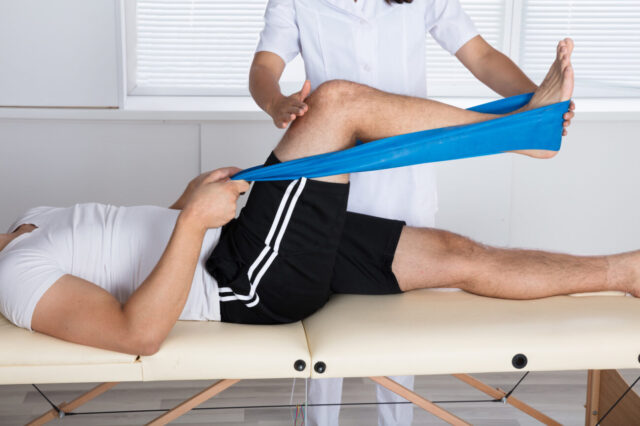
- Physical therapy ─ A physical therapist can design a personalized treatment plan. This will include exercises designed to strengthen the muscles that support the back and hips, improve flexibility, and reduce pain.
- Manual therapy ─ Techniques such as massage, mobilization, and manipulation by a qualified therapist can help alleviate pain and improve function.
- Alternative therapies ─ Acupuncture, chiropractic care, and yoga have been beneficial for some individuals in managing pain and enhancing mobility.
Role of Rest and Recovery
- Adequate rest ─ Allow your body time to heal by taking a break from pickleball or any strenuous activities that trigger pain.
- Gradual return to play ─ Once the pain subsides, gradually reintroduce pickleball activities, starting with light play and progressively increasing its intensity based on comfort and ability.
- Preventive measures ─ Incorporate the prevention strategies previously discussed to avoid the recurrence of pain and injury.
Enhancing Your Pickleball Experience
Injury doesn’t mean the end of your pickleball journey. With the right approach, you can return to the court stronger and more resilient. Here’s how to enhance your pickleball experience post-injury and prevent future issues.
Gradual Return to Play
- Start slow ─ Begin with light hitting sessions or drills that do not strain your back or hips. Avoid jumping straight into competitive play.
- Incremental intensity ─ Gradually increase the duration and intensity of your play. Monitor your body’s response to ensure you do not overdo it.
- Focus on technique ─ Use this time to refine your technique with a focus on movements that minimize stress on your back and hips.
Cross-Training for Pickleball Fitness
- Diversify your exercise routine ─ Engage in activities that complement pickleball by improving cardiovascular health, flexibility, and muscle strength. Swimming, cycling, and yoga are excellent options.
- Strength training ─ Incorporate exercises that strengthen the core, legs, and back muscles, which are crucial for pickleball. This can help improve your game and reduce the risk of injury.
- Balance and agility work ─ Activities that enhance balance and agility can improve your footwork and reduce the likelihood of falls or awkward movements on the court.
Listening to Your Body
- Recognize warning signs ─ Pay attention to any signs of discomfort, fatigue or pain. These could indicate overuse of muscles or the onset of an injury.
- Rest and recovery ─ Prioritize rest days and recovery time, especially if you notice signs of overuse. Allowing your body to heal is crucial for long-term participation in any sport.
- Seek professional advice ─ If you experience persistent pain or discomfort, consult a healthcare provider or physical therapist for professional assessment and guidance.
Conclusion
Pickleball, with its blend of fun, competition, and physical activity, offers numerous benefits but also poses challenges, particularly to the back and hips. This article has explored the common causes of pain associated with the sport, identified typical injuries, and provided strategies for prevention, treatment, and enhancing the pickleball experience.
Pickleball should be a source of joy, not discomfort. With the right precautions and attitudes towards health and fitness, players can look forward to many years of engaging in this dynamic sport. Remember, the goal is not just to play pickleball, but to thrive in it, enjoying every game safely and pain-free.


